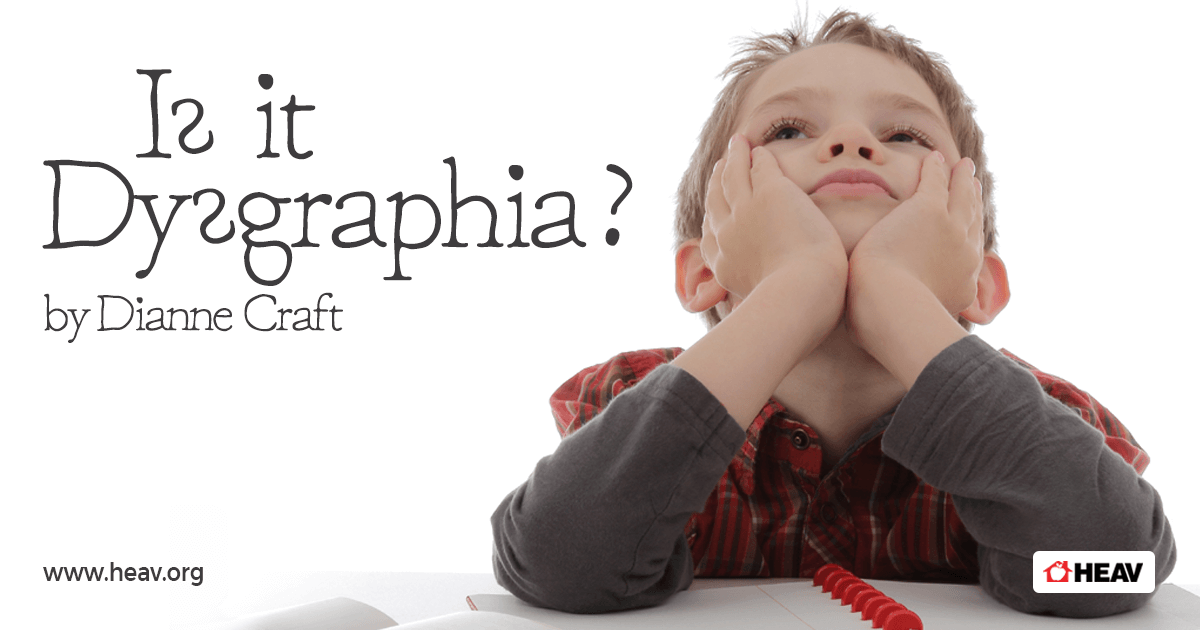Is It Dysgraphia?
By: Dianne Craft, MA, CNHP
One of the most common and misdiagnosed processing problems in children is a blocked writing gate. This is the number one processing glitch in gifted children. Many of these children seem to be “allergic” to their pencils. They break out in whining as soon as they get a pencil or pen in their hand.
Let’s look at what is happening in the brain of this child when he is asked to write something.
How the Brain Works
Our left-brain hemisphere is designed to concentrate on learning a new task such as driving a car or riding a bike. After some concentrated practice, that task is then supposed to transfer over the brain midline into the right brain, which is responsible for the automaticity of the process.
If we imagine the left brain hemisphere as the “Concentrating Brain” and the right hemisphere as the “Automatic Brain,” we can see how this transfer allows us to “think and do” at the same time. Generally, when we teach a child how to write, after six months of practice that writing crosses over into the automatic brain hemisphere so the child can “think and write” at the same time. For many children, this transfer does not easily occur. Thus, they have to expend so much more battery energy or concentration to a writing task than do other children. Dr. Mel Levine in his book, One Mind at a Time, calls these learning blocks “energy leaks.”
This particular blocked learning gate or “energy leak” can be called a grapho-motor processing problem, a visual/motor integration problem, a fine motor problem, or dysgraphia.
This often explains why many students learn their spelling words easily by writing them in a workbook or writing them five times each, but another child can write his words hundreds of times and still not store the spelling word in his long-term memory. Now we realize that this struggling child has to use his “battery energy” just for the writing process, so the spelling words cannot be transferred into the right brain where his long-term memory is stored. Thus, the method of copying to learn is totally ineffective for this child.
Symptoms of Blocked Writing Gate
- Frequent or occasional reversals in letters (after age seven)
- Makes many letters from bottom to top (vertical reversals)
- Writing is very labor-intensive
- Copying is poor, takes a long time…or is like artwork
- Mixes capital and small letters in writing
- Great stories orally, but writes very little
- Does all math problem mentally to avoid writing them down
- Lining up numbers in math is difficult
- Can’t listen and take notes at the same time
How to Compensate
- Reduce the amount of writing a child needs to do during the day (especially workbooks). Have him answer more questions orally.
- Reduce or eliminate copying for three to four months.
- Use another method of teaching spelling words that does not include writing in a workbook or writing multiple times. Right-brain spelling uses a child’s photographic memory to teach spelling without writing.
- Teach the child keyboarding for some writing projects. However, most children who have dysgraphia also find keyboarding quite labor intensive.
How to Correct
It is important to not just compensate for this writing glitch, but to also take steps to eliminate this, so the child can experience fluency in the writing process, and can take notes while listening–an important skill when older. You can work with an occupational therapist to reduce the stress on the writing system, or use the home method that I used with my students to eliminate dysgraphia or any writing or visual/spatial glitch.
Many years ago, a very wise optometrist, Dr. Getman, developed a unique exercise that crosses the midline to open the child’s writing gate. This exercise eliminates writing reversals, increases writing fluency, and actually rehabilitates the child’s visual/spatial system (internalizing directionality). By doing this simple exercise for 10 minutes a day, I found that my students ability to “think and write” at the same time improved immensely. They no longer needed to come into my “pull-out” language arts class for remediation. In later years, as my students contacted me, I found that many of them decided to major in journalism in college. That was a thrill to hear!
This powerful midline exercise that uses the “hand to heal the brain”, will be demonstrated in the workshop,” Is It Dysgraphia?” at the HEAV 2018 convention by my associate, Pamela Gates. If you can’t attend this workshop, but want to know how to help your child overcome dysgraphia, I have a DVD available entitled, “Smart Kids Who Hate to Write.”
CONCLUSION
A child can have a learning glitch or block in a learning gate that causes him to struggle every day with schoolwork without the parents’ knowledge. Using simple checklists, the parent can identify this problem and design the school day to be less frustrating. More importantly, the parent can avail herself of all the wonderful corrective techniques so that the child does not need to struggle with the burden of having to work so hard at writing because of dysgraphia.
Dianne Craft is a former homeschooling mom who has a master’s degree in special education and is a Certified Natural Health Professional. She has created many home programs to help eliminate learning disabilities. To learn more about how to work with bright, hard-working kids and teens who have to work too hard to learn, come to the workshops at the HEAV convention presented by Dianne’s protégé, Pamela Gates.
Pam is a Certified Learning Specialist and CNHP, also. The specific exercise to eliminate dysgraphia will be presented in these workshops, along with other vital exercises and right-brain teaching strategies to make learning easier for your child at home. Visit her website, www.diannecraft.org, for daily lesson plans and many articles on children and learning.
For more insightful and encouraging homeschool related articles, homeschool living tips, and homeschool connections, please visit our HEAV blog. Click here!










